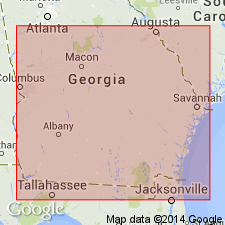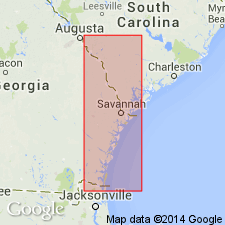
- Usage in publication:
-
- Wabasso beds
- Modifications:
-
- First used
- AAPG geologic province:
-
- Atlantic Coast basin
Summary:
Wabasso beds is an informal name applied here to lower Pliocene, phosphatic, calcareous, and microfossiliferous, variably argillaceous, silty, fine-grained to very fine grained sand in the subsurface of the coastal area of GA, southern SC, and eastern FL. They are included in the Hawthorne Group because they are lithologically similar to other Hawthorne units in eastern GA. Though discontinuous in GA and SC, they appear to be thick and widespread in eastern and southern FL and may be raised to formation rank in the future. Unit was previously called Indian River beds by Huddlestun and others (1982) and were included within the Duplin Marl by Herrick (1976) and Woolsey (1976). The Wabasso beds disconformably overlie the Tybee Phosphorite Member (new name) of the Coosawhatchie Formation in Chatham Co., GA, though at the type in FL, the beds overlie an undifferentiated sand of the Hawthorne Group. The beds disconformably underlie the Satilla Formation or the Nashua Formation. Thickness is approximately 82 ft (25 m) in the core Phred 1. Thicknesses in GA wells measured 25 and 28 ft. Age of early Pliocene (Zanclean) is based on planktonic Foraminifera.
Source: GNU records (USGS DDS-6; Reston GNULEX).

- Usage in publication:
-
- Wabasso beds*
- Modifications:
-
- Biostratigraphic dating
- AAPG geologic province:
-
- Atlantic Coast basin
- South Georgia sedimentary province
Summary:
Huddlestun (1988) suggested that Foraminifera indicated a late early Pliocene age for Wabasso beds indicative of Zone PL1 of Berggren (1973). GLOBOGERINA NEPENTHES suggests an age of no younger than 4.2 to 4.0 Ma. GLOBOGERINA MARGARITAE MARGARITAE suggests an age no older than about 5.7 Ma (J.E. Hazel, Louisiana State University, 1991, oral commun.). Sediments represent major late early Pliocene transgression, probably time equivalent to Sunken Meadow Member of Yorktown Formation in southeastern VA and northeastern NC. Available data do not preclude possibility that Wabasso beds are as old as upper Miocene.
Source: GNU records (USGS DDS-6; Reston GNULEX).
For more information, please contact Nancy Stamm, Geologic Names Committee Secretary.
Asterisk (*) indicates published by U.S. Geological Survey authors.
"No current usage" (†) implies that a name has been abandoned or has fallen into disuse. Former usage and, if known, replacement name given in parentheses ( ).
Slash (/) indicates name conflicts with nomenclatural guidelines (CSN, 1933; ACSN, 1961, 1970; NACSN, 1983, 2005, 2021). May be explained within brackets ([ ]).

